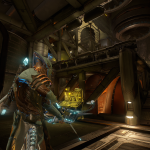Last year it was only in April, but this time the spring cleaning of AMD’s drivers is already in March. Six days before the GDC keynote, AMD is now releasing RSR, i.e. the Radeon Super Sampling based on Fidelity FX Super Sampling, to the gaming world today and it will be interesting to test this new implementation in practice soon. In contrast to FSR 2.0, which is to be seen as a direct competitor to DLSS 2.0 and must also be implemented in the respective game, RSR works purely on the driver level and is thus equally effective for all games.
Of course, the picture quality will also determine the success here and, as always, we will have to wait and see how the whole thing presents itself across the entire range of current and older games. Even if AMD certainly only publishes best-case screens, it all looks quite promising so far:
RSR launches today, March 17, in the form of the new driver. In summary, RSR is basically FSR, but now works at the driver level and for all games. Unfortunately, RSR only works on newer Radeon GPUs from the Navi architecture and will offer a lower quality than FSR 2.0, since the algorithm has to upscale the entire image in the end (including the user interface and menus) and not only the game-relevant content from the 3D scene.
FSR 2.0, Temporal Data and Anti-Aliasing
FSR 2.0 will offer better image quality in all displays and resolutions according to AMD (and first short tests on my part). This technology will, as expected, be based on temporal data and will also offer optimized anti-aliasing. In this respect, it could thus position itself as a real competitor for NVIDIA’s DLSS 2.0. FSR 2.0 still does not require specialized machine learning cores (for NVIDIA Tensor Cores), but there is currently no list of supported GPUs in the slides either. AMD notes, however, that there will be “a wide range of products and platforms, both from AMD and competitors” that it will support. Whether this also means graphics hardware from NVIDIA or Intel can unfortunately not be verified further.
FSR 2.0 includes integrated antialiasing and will also offer a higher image quality than FSR, which first impressions could definitely confirm. Of course, we will have to test this more thoroughly, but AMD kindly provides suitable pictures for a first comparison:
Nothing more specific is known about a freely available open source code so far. However, since Intel XeSS will be released as open source code, a corresponding offer from AMD is also to be expected. Of course, more details are still missing on support for non-AMD hardware, too, because in the end the slides shown here are just a teaser for GDC 2022 (see the last slide of the FSR intro), so most of the information about FSR 2.0 will be presented on March 23.
Beyond that, AMD has hidden even more features in the driver and also points out in the slides that the driver performance could partly increase significantly in many games in the past months. Fine Wine at it’s best, as always.






























































31 Antworten
Kommentar
Lade neue Kommentare
Urgestein
Urgestein
Mitglied
Urgestein
Mitglied
Urgestein
Urgestein
Urgestein
Urgestein
Urgestein
Mitglied
Urgestein
Mitglied
Mitglied
Urgestein
Mitglied
Urgestein
Mitglied
Urgestein
Alle Kommentare lesen unter igor´sLAB Community →